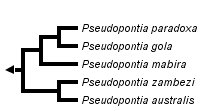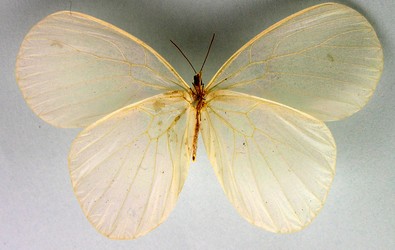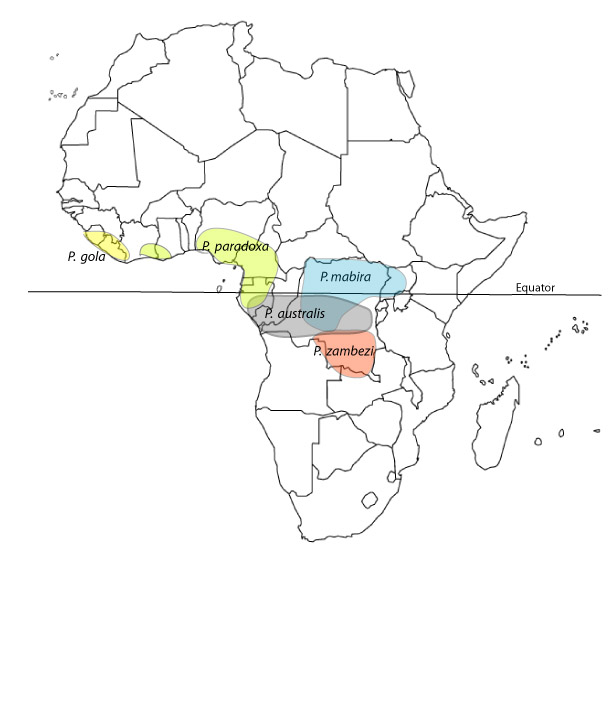Pseudopontiinae
Pseudopontia
the Frail Whites, or Ghosts
Andrew V. Z. Brower


This tree diagram shows the relationships between several groups of organisms.
The root of the current tree connects the organisms featured in this tree to their containing group and the rest of the Tree of Life. The basal branching point in the tree represents the ancestor of the other groups in the tree. This ancestor diversified over time into several descendent subgroups, which are represented as internal nodes and terminal taxa to the right.

You can click on the root to travel down the Tree of Life all the way to the root of all Life, and you can click on the names of descendent subgroups to travel up the Tree of Life all the way to individual species.
For more information on ToL tree formatting, please see Interpreting the Tree or Classification. To learn more about phylogenetic trees, please visit our Phylogenetic Biology pages.
close boxIntroduction
This genus of small, delicate Afrotropical pierids has been considered to be the sister taxon of all other Pieridae. The Braby et al. (2006) cladogram places it as sister group to Dismorphiinae. Long viewed as a single species, the recent combined analysis of Mitter et al (2011) shows the genus to be comprised of a complex of five allo- or parapatric species.
- Pseudopontia paradoxa (R. Felder, 1869) is found in Cameroon, Nigeria, Cote d'Ivoire, Ghana, Gabon
- Pseudopontia australis (F.A. Dixey, 1923), formerly considered a subspecies, is found in Democratic Republic of Congo (Kinshasa), Congo (Brazzaville), and eastern Gabon, usually at low elevation
- Pseudopontia gola (Sz. Safian and K. Mitter, 2011) is found in Sierra Leone and Liberia in far western Africa
- Pseudopontia mabira (K. Mitter and S. Collins, 2011) is found in central Africa, in Uganda and Democratic Republic of Congo within about 5 degrees latitude north and south of the Equator
- Pseudopontia zambezi (K. Mitter and W. De Prins, 2011) is found in riverine forests in the southern African highlands in Democratic Republic of Congo, northwestern Zambia, and Angola at elevations over 800m above sea level
Discussion of Phylogenetic Relationships
The tree is based on the maximum likelihood analysis of four gene regions (CAD, DDC, wingless, mtDNA COI)illustrated in Fig. 8D of Mitter et al. (2011).Other Names for Pseudopontia
- Pseudopontiinae
- Globiceps
- Gonophlebia
- Vernacular Names: the Frail Whites, or Ghosts
References
Braby, M. F. 2005. Provisional checklist of genera of the Pieridae (Lepidoptera: Papilionidae). Zootaxa 832:1–16.
Braby, M., R. Vila, and N. E. Pierce. 2006. Molecular phylogeny and systematics of the Pieridae (Lepidoptera: Papilionoidea): higher classification and biogeography. Zoological Journal of the Linnean Society 147(2):239-275.
Dixey, F.A. 1923. Pseudopontia paradoxa: its affinities, mimetic relations, and geographical races. Proceedings of the Entomological Society (London), lxi–lxvii + plate B.
Felder, R. 1869. [no title]. Petites Nouvelles Entomologiques, 1, 30–31.
Felder, R. 1870. Gonophlebia (Globiceps), Paradoxa (Felder). Petites Nouvelles Entomologiques, 1, 95.
Larsen, T. B. 2005 Butterflies of West Africa. Stenstrup, Denmark: Apollo Books.
Mitter, K.T., Larsen, T.B., de Prins, W., de Prins, J., Collins, S., Vande Weghe, G., Sáfián, S., Zakharov, E.V., Hawthorne, D.J., Kawahara, A.Y.,Regier, J.C. 2011. The butterfly subfamily Pseudopontiinae is not monobasic: marked genetic diversity and morphology reveal three new species of Pseudopontia (Lepidoptera: Pieridae). Syst. Entomol. 36: 139-163. DOI: 10.1111/j.1365-3113.2010.00549.x
Plötz, C. 1870. Pseudopontia Calabarica n. gen. et n. sp. Stettiner Entomologischer Zeitung, 31, 348–349, 1 pl.
Title Illustrations

| Scientific Name | Pseudopontia australis |
|---|---|
| Location | DEMOCRATIC REPUBLIC OF CONGO: Kasai Province, Luebo, 1345 ft. |
| Specimen Condition | Dead Specimen |
| Identified By | Torben B. Larsen |
| Sex | Male |
| Life Cycle Stage | adult |
| View | ventral |
| Collection | Natural History Museum, London |
| Type | Lectotype |
| Collector | Paul Landbeck |
| Copyright | © 2011 |
About This Page

Middle Tennessee State University, Murfreesboro, Tennessee, USA
Correspondence regarding this page should be directed to Andrew V. Z. Brower at
Page copyright © 2011
 Page: Tree of Life
Pseudopontiinae . Pseudopontia . the Frail Whites, or Ghosts.
Authored by
Andrew V. Z. Brower.
The TEXT of this page is licensed under the
Creative Commons Attribution License - Version 3.0. Note that images and other media
featured on this page are each governed by their own license, and they may or may not be available
for reuse. Click on an image or a media link to access the media data window, which provides the
relevant licensing information. For the general terms and conditions of ToL material reuse and
redistribution, please see the Tree of Life Copyright
Policies.
Page: Tree of Life
Pseudopontiinae . Pseudopontia . the Frail Whites, or Ghosts.
Authored by
Andrew V. Z. Brower.
The TEXT of this page is licensed under the
Creative Commons Attribution License - Version 3.0. Note that images and other media
featured on this page are each governed by their own license, and they may or may not be available
for reuse. Click on an image or a media link to access the media data window, which provides the
relevant licensing information. For the general terms and conditions of ToL material reuse and
redistribution, please see the Tree of Life Copyright
Policies.
- First online 04 October 2006
- Content changed 20 March 2011
Citing this page:
Brower, Andrew V. Z. 2011. Pseudopontiinae . Pseudopontia . the Frail Whites, or Ghosts. Version 20 March 2011 (under construction). http://tolweb.org/Pseudopontia/12214/2011.03.20 in The Tree of Life Web Project, http://tolweb.org/








 Go to quick links
Go to quick search
Go to navigation for this section of the ToL site
Go to detailed links for the ToL site
Go to quick links
Go to quick search
Go to navigation for this section of the ToL site
Go to detailed links for the ToL site